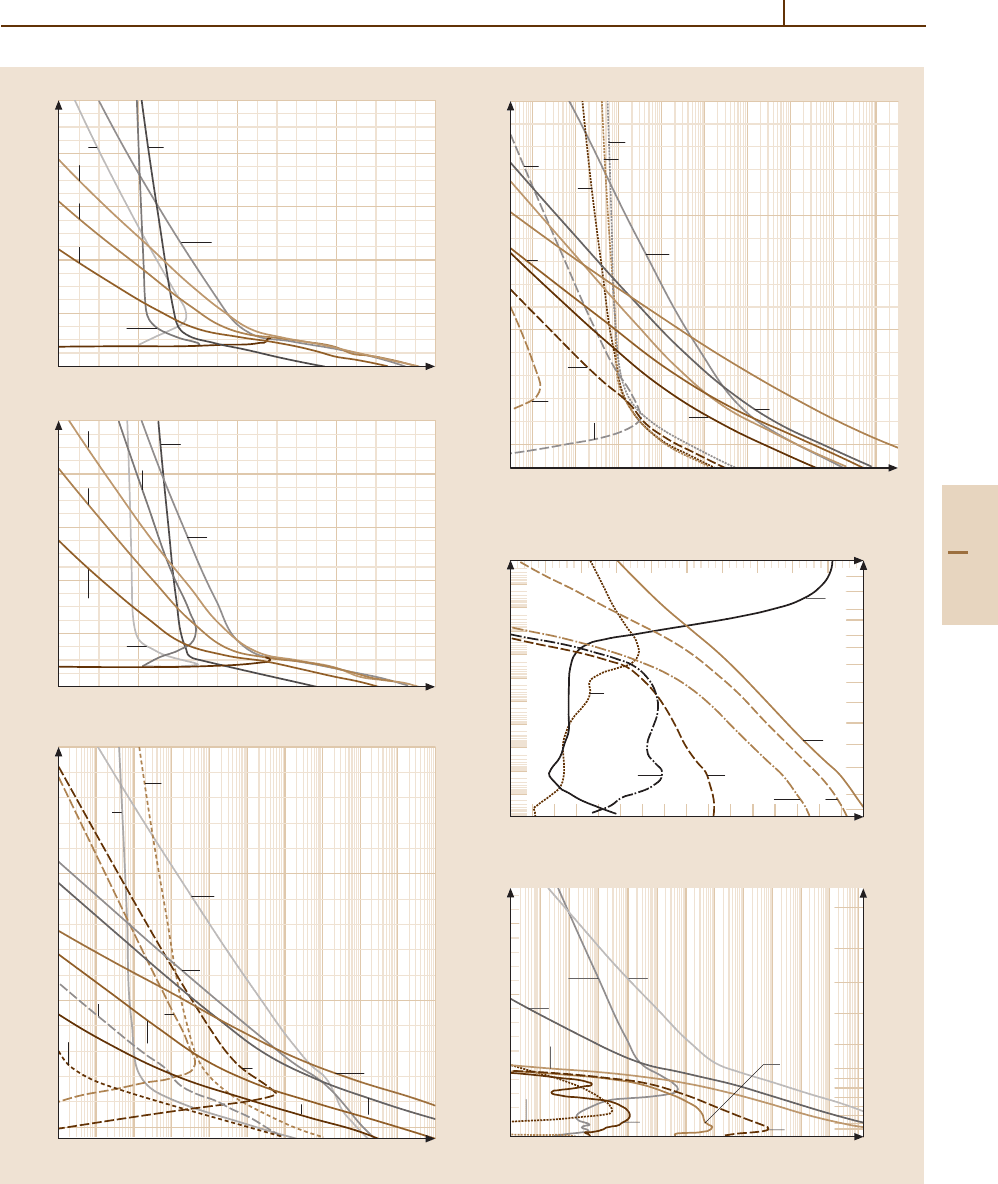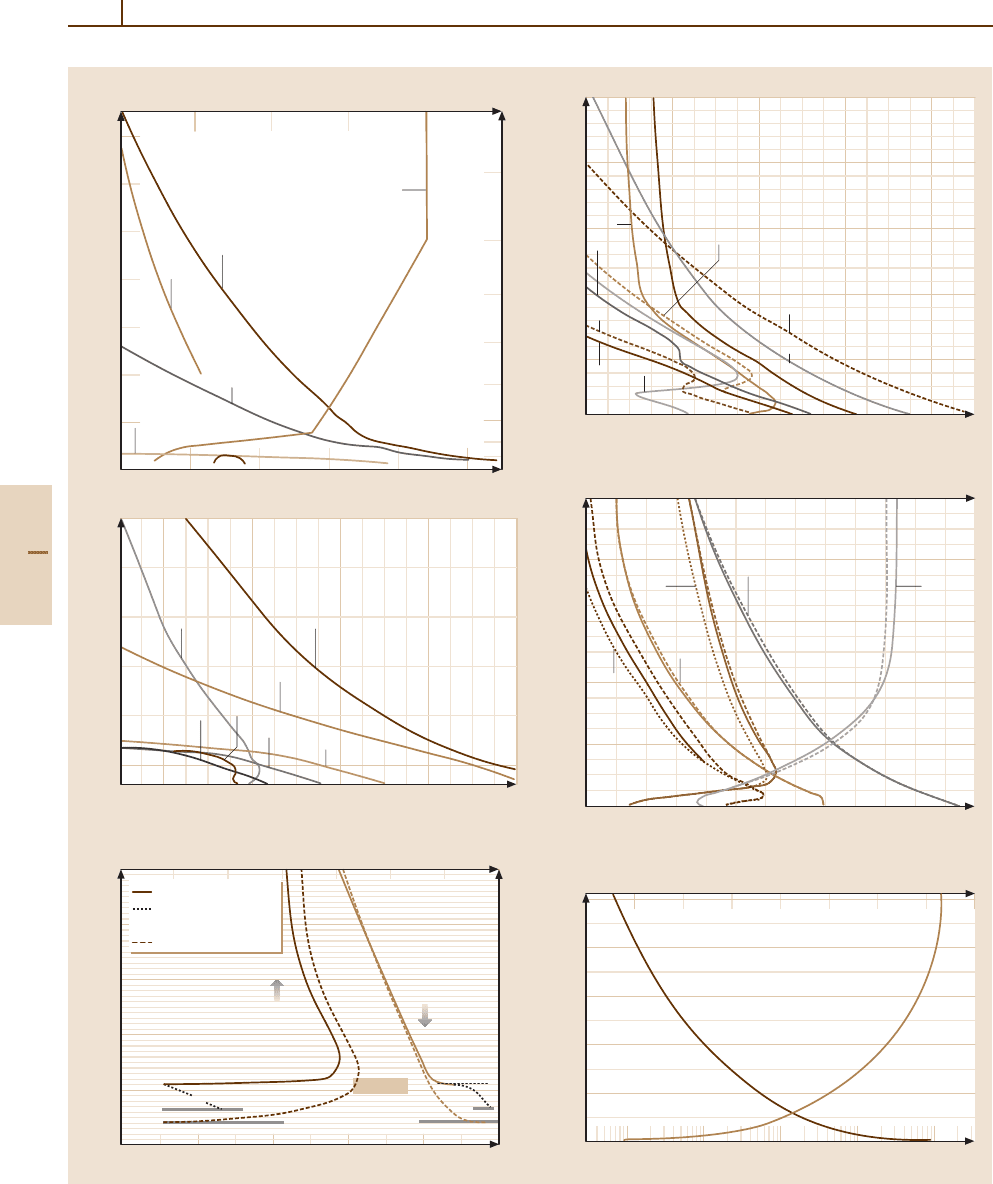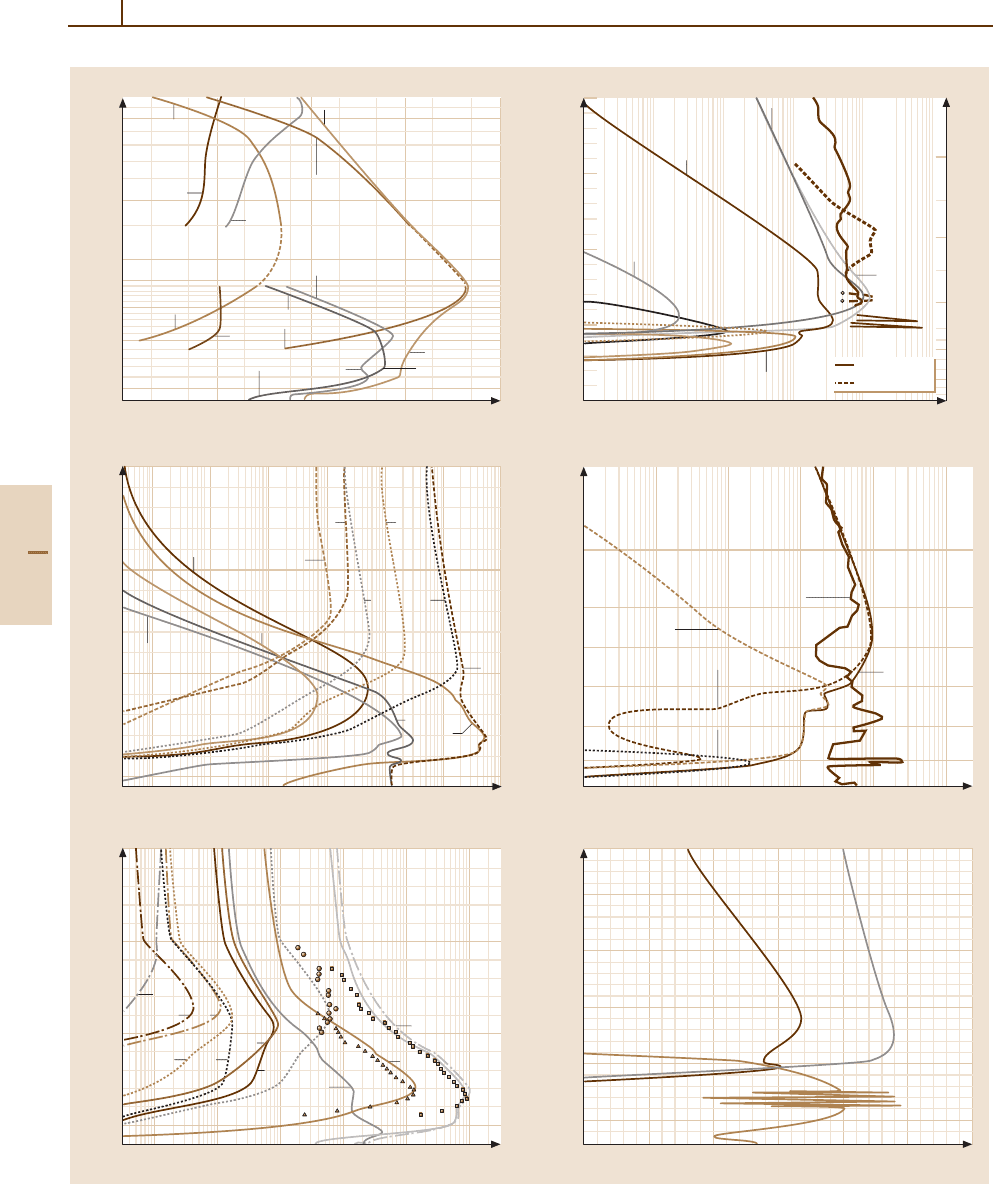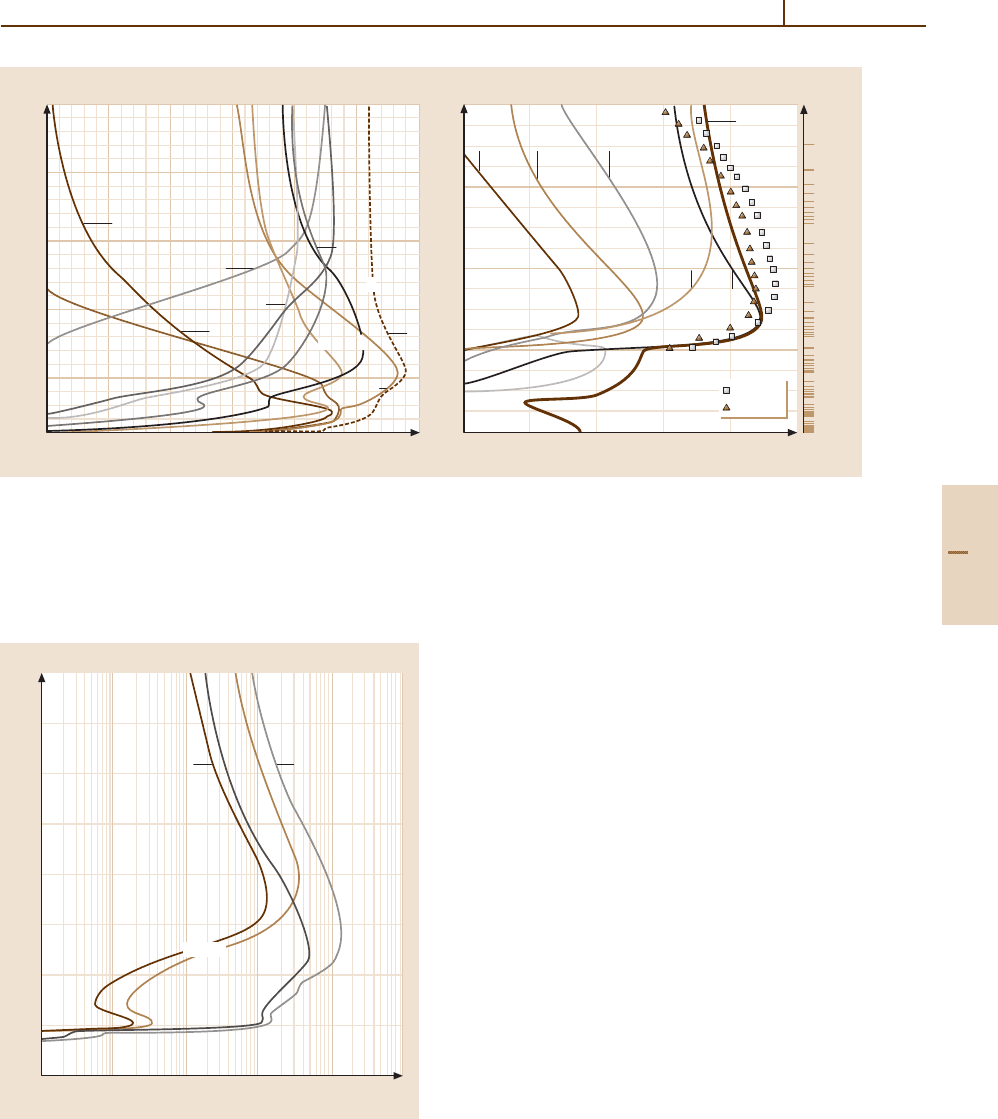Drake G.W.F. (editor) Handbook of Atomic, Molecular, and Optical Physics
Подождите немного. Документ загружается.


Aeronomy 84.4 Ionospheres 1273
e, hv
N
2
+
15.6
He
+
24.5
N
+
14.02
CO
+
14.01
CO
2
+
13.76
C
+
11.20
NO
+
9.76
O
+
(
4
S)
13.62
H
+
13.60
O
2
+
12.1
O
+
(
2
D)
16.0
O
2
O
CO
2
CON
2
He H
CO
O
2
CO
2
CO
2
CO
2
CO
2
CO
2
O
2
CO
2
,O
2
O, O
2
CO
2
CO,CO
2
CO
2
, O
2
O
2
,CO
2
O,O
2
O
2
O
2
CO,
CO
2
O
O
H
NO
O
N
OO
C
N
NO
N
2
N
2
N
2
,N,NO
O
2
,
NO
N (
2
D)
N
2
, NO
NO
NO
NO
NO
C
N(
2
D)
N, NO, N(
2
D)
e,hv
e,hv e,hve,hve,hv e,hv e,hve,hv e,hv e,hv e,hv e,hv e,hv
Fig. 84.8 Diagram illustrating the ion chemistry in the ionospheres of the terrestrial planets. The numbers under the
names of the ions indicate the ionization potentials of the parent neutral. In the presence of sufficient neutral densities,
the ionization flows downward, the importance of dissociative recombination for the molecular ions increases as the
ionization potentials of the parent neutrals decrease
Table 84.9 Ionization potentials (I
P
) of common atmospheric species
a
High I
P
Medium I
P
Ionized by Ly α
Species
I
P
(eV ) Species I
P
(eV ) Species I
P
(eV )
He 24.59 CH
4
12.61 C
4
H
2
10.18
Ne 21.56 CH
4
12.51 CH
3
9.84
Ar 15.76 O
2
12.32 C
3
H
6
9.73
N
2
15.58 O
2
12.07 NO 9.264
H
2
15.43 C
2
H
6
11.52 C
2
H
5
8.13
N 14.53 C
2
H
2
11.40 HCO 8.10
CO 14.01 C 11.26 C
3
H
7
8.09
CO
2
13.77 C
3
H
8
10.95 Mg 7.65
O 13.62 CH 10.64 trans-HCNH 7.0
b
H 13.60 C
2
H
4
10.51 cis-HCNH 6.8
b
HCN 13.60 CH
2
10.40 Ca 6.11
OH 13.00 S 10.35 Na 5.14
a
Computed with data taken from [84.50], except as noted;
b
From [84.51]
Part G 84.4

1274 Part G Applications
In ionospheres where hydrogen is abundant and suf-
ficient neutral densities are present, ionization flows to
species formed by protonation of neutrals that have large
proton affinities. There are no in situ measurements of
the ion composition of the outer planets, but models pre-
dict that H
+
3
and hydrocarbon ions dominate the lower
ionospheres. In regions where meteor ablation occurs,
metal ions may also be found.
Many ion–molecule reactions proceed at or near gas
kinetic (or collision) rates. The interaction of an ion with
a nonpolar molecule is dominated by the ion-induced-
dipole interaction, for which the interaction potential
is −
1
2
α
d
q
2
/r
4
,whereα
d
is the polarizability of the neu-
tral, q is the charge on the ion, and r is the distance
between the particles. The Langevin rate coefficient is
then given by
k
L
= 2πq(α
d
/µ)
1/2
, (84.47)
where µ is the reduced mass of the two species. For
a singly charged ion, with α
d
in Å
3
and µ in atomic mass
units, this formula reduces to 2.34×10
−9
(α
d
/µ)
1/2
.The
rate coefficient for an ion with a polar molecule is
k
d
=
2πq
µ
1/2
α
1/2
d
+cµ
d
2
πk
B
T
1/2
,
(84.48)
where µ
d
is the dipole moment and c is a constant
that is unity in the locked dipole approximation and is
about 0.1 in the average dipole orientation (ADO)the-
ory. Theories for ion–quadrupole interactions have also
been developed, and the resulting formulas can be found
in, for example, the review by Su and Bowers [84.59].
Measured rate coefficients for ion–molecule reactions
have been compiled by Anicich et al. [84.60]andIkezoe
et al. [84.61].
Loss of ionization in planetary atmospheres pro-
ceeds mainly by dissociative recombination of molecu-
lar ions, which may be represented by
AB
+
+e
−
→ A+ B . (84.49)
Fig. 84.9a–k Model thermospheres for the Earth and planets. The curves are number density profiles and are labeled
by the species they represent.
(a) Earth, based on the MSIS model of [84.17] for a latitude of 45
◦
, a local time of noon
for low (top) and high (bottom) solar activities;
(b) High solar activity model of Venus, based on the model of [84.3]
for 15
◦
N latitude 15 h local time; (c) Low solar activity model of Mars, based on Viking 1 measurements [84.8].
Adapted after [84.52];
(d) Jupiter, After [84.53]. (e) Saturn, After [84.54]. (f) Uranus, after [84.55]; (g) Neptune [84.56];
(h) Pluto [84.57]. The abscissa is given in units of Pluto radii, and the ordinate in the top plot is number density in
cm
−3
; the bottom is temperature in K. (i) Titan, After [84.10, 12]; and (j) Triton model, after [84.15]; (k) Io model,
temperature (upper scale), and number density (lower scale). The major constituent is SO
2
, and transient with a lifetime
of 2–3 days. From Strobel and Wolven [84.58]. The short dashed curves are for solar ionization only, and the solid
and long-dashed curves are for different assumptions about the interaction of Triton’s thermosphere with electrons from
Neptune’s magnetosphere. The solid curves are the recommended model
(j)
Dissociative recombination coefficients are charac-
teristically large, about 10
−7
cm
3
/s, at the electron
temperatures T
e
typical of planetary ionospheres, which
are usually within a factor of two or so of the neu-
tral T ≈ 200–2000 K near the molecular ion density
peak. Daytime peak electron densities are usually in
the range 10
4
–10
6
cm
−3
, and fractional ionizations are
small, about 10
−5
, near the F
1
peak.
The relative importance of ion–molecule reactions
and dissociative recombination in the destruction of
a particular ion is determined by the relative densities
of electrons and neutrals with which the ions can react.
In general, molecular ions whose parent neutrals have
high I
P
are transformed by ion–molecule reactions pref-
erentially to loss by dissociativerecombination, and their
peak densities occur higher in the atmosphere. Ions for
which dissociative recombination is an important loss
mechanism near the ion peaks of the terrestrial plan-
ets include NO
+
and O
+
2
, and in the atmospheres of the
outer planets, H
+
3
and hydrocarbon ions. For ions with
very high I
P
,suchasN
+
2
and H
+
2
, dissociative recombi-
nation is rarely important as a loss process, except at very
high altitudes. It may, however, be important as a source
of vibrationally or electronically excited fragments or
hot atoms.
Atomic ions may be destroyed by radiative recom-
bination:
X
+
+e
−
→ X +hν, (84.50)
but the rate coefficients are small, about 10
−12
cm
3
/sat
the typical T
e
of planetary ionospheres [84.62]. Atomic
ions may dominate at high altitudes, where neutral dens-
ities are low, but in such regions, loss by downward
diffusion is more important than chemical recombina-
tion. The ions diffuse downward to altitudes where the
neutral densities are higher and are then destroyed in
ion–molecule reactions. The major ions in the topside
ionospheres of the planets tend to be atomic ions: O
+
in
the ionospheres of Earth and Venus, and H
+
in the iono-
Part G 84.4

Aeronomy 84.4 Ionospheres 1275
log density (cm
–3
)
1000
800
600
400
200
0
5 101520
1000
800
600
400
200
0
5 101520
10
3
10
4
10
5
10
6
10
7
10
8
10
9
10
10
10
11
10
12
10
13
400
300
200
100
400
300
200
100
10
4
10
5
10
6
10
7
10
8
10
9
10
10
10
11
10
12
10
–7
10
–6
10
–5
10
–4
10
–3
10
–2
10
–1
10
0
10
1
10
2
10
3
10
4
900 10000 100 200 300 400 500 600 700 800
1000
800
600
500
400
350
300
250
200
150
100
50
0
–50
10
4
10
5
10
6
10
7
10
8
10
9
10
10
10
11
10
12
3000
2000
1000
0
10
13
10
14
10
15
10
16
10
–10
10
–8
10
–6
10
–4
1
log density (cm
–3
)
Density (cm
–3
)
Density (cm
–3
)
Density (cm
–3
)
10
5
10
10
10
15
10
20
Number density (cm
–3
)
Altitude (km)
F
10.7
= 75
F
10.7
= 200
Altitude (km)
Altitude (km)
He
O
N
O
2
Ar
H
N
2
He
O
N
O
2
Ar
H
N
2
He
O
N
O
2
Ar
H
N
2
CO
2
CO
C
NO
H
2
Venus
Hi standard
He
O
N
O
2
Ar
H
N
2
CO
2
CO
C
NO
H
2
Mars
Low solar activity
Altitude (km)
H
2
CH
4
C
2
H
6
C
2
H
2
H
He
Pressure (mbar)
Temperature (K)
Altitude (km)
Altitude (km) Pressure (mbar)
H
2
CH
4
C
2
H
6
C
2
H
2
H
He
H
2
O
CH
3
C
2
H
T
a)
b)
c)
d)
e)
Gladstone NEB
Model
Atmosphere
Part G 84.4

1276 Part G Applications
log density (cm
–3
)
7000
6000
5000
4000
3000
2000
1000
1000
800
600
400
200
0
20 40 60 80 100 120
6
8 10121416
200 400
600
800
–6
–5
–4
–3
–2
–1
0
2
log
10
n (cm
–3
)
3000
2500
2000
1500
1000
500
6 8 101214
1600
1500
1400
1300
1200
1100
10
6
10
8
10
10
10
12
10
14
log densities (cm
–3
)
Number density (cm
–3
)
10
–2
10
–1
1
10
20 40 60 80 100 120 140 160
1000
800
600
400
200
0
8101246
8 9 10 11 12 13 1434567 1516
3000
2500
2000
1500
1000
log densities (cm
–3
)
0 500 1000 1500
10
6
10
7
10
8
10
9
10
10
Number density (cm
–3
)
Altitude (km)
He
HC
H
N
2
CH
4
C
2
H
6
C
2
H
2
Temperature (K)
H
2
Altitude (km)
He
H
H
2
C
2
H
4
Neptune
Temperature (K)Radial distance (km) Pressure (µbar)
Altitude (km)
Temperature (K)Altitude (km)
Temperature (K)
Height (km)
N(z)
T
CH
4
C
2
H
6
C
2
H
2
CO
H
H
2
C
2
H
4
C
4
H
2
N
2
H
2
T
N
H
Titan
Hybrid model
(troposphere
extension)
High density model
T
min
= 35 K
T
surf
= 57 K
T
surf
= 37 K
Γ
d
(N
2
) = –0.5 K/km
n(z)
T(z)
T(z)
1208
1164
1140
τ
v
= 0.15
f)
g)
i)
k)
j)
h)
log
10
P
H
2
(µbar)
Part G 84.4

Aeronomy 84.4 Ionospheres 1277
spheres of the outer planets. On Mars, however, the O
+
peak density does not exceed that of O
+
2
even at high
altitudes.
Model thermospheres for Earth and selected planets
and satellites are shown in Fig. 84.9a–k. Measured or
computed ion density profiles for the Earth and selected
planets and satellites are shown in Fig. 84.10a–h.
84.4.3 Nightside Ionospheres
Nightside ionospheres can result from several sources
including remnant ionization from dayside, like O
+
in the terrestrial ionosphere. While the lower molecu-
lar ion layers recombine, the F
2
peak persists through
the night, although it rises and the peak density is re-
duced by a factor of 10. Electron density profiles for
day and night at high and low solar activities are shown
in Fig. 84.11. In the auroral regions of the Earth, the
precipitating electrons may also produce significant ion-
ization, which maximizes in the midnight sector of the
auroral oval.
The nightside ionosphere of Venus is highly vari-
able, but has been shown to contain the same ions as the
dayside ionosphere. The densities are, however, lower
by factors of 10 or more than those of the dayside iono-
sphere, and the average peak in the electron density
profile is about (1to2) ×10
4
cm
−3
. It is produced by
a combination of precipitation of suprathermal elec-
trons that have been observed at high altitudes in the
umbra, and transport of atomic ions (mostly O
+
)athigh
altitudes from the dayside. For Mars, only a narrow
range of solar zenith angles near the terminator at low
solar activity has been measured by the radio occulta-
tion experiments on the Viking spacecraft [84.63], the
Mariner 9 spacecraft, and more recently by the Mars
Global Surveyor (MGS) spacecraft radio sciences (RS)
experiment [84.64]. The electron densities are appar-
ently low, and no composition information is available.
At this time, there is no information available about the
nightside ionospheres of the other planets.
84.4.4 Ionospheric Density Profiles
Density profiles of molecular ions can often be approxi-
mated as idealized Chapman layers. A Chapman layer of
ions is one in which the ions are produced by photoion-
ization and lost locally by dissociative recombination.
The ionization rate q
i
in a one-species Chapman layer
for monochromatic radiation is given by
q
i
= Fσ
i
n , (84.51)
where σ
i
is the ionization cross section, and
F = F
∞
exp[−τ(z)] is the local solar flux. For an
isothermal atmosphere, the scale height is approximately
constant and therefore n = n
0
exp(−z/H). Sometimes
an ionization efficiency η
i
is defined such that
σ
i
= η
i
σ
a
. (84.52)
Near threshold, the ionization efficiency for molecules
is usually about 0.3–0.7 but it increases rapidly to 1.0
at shorter wavelengths.
Since the maximum ionization rate in an isother-
mal atmosphere occurs where the optical depth (τ =
nHσ
a
sec χ) is unity and therefore n = 1/(σ
a
H sec χ),
the maximum ionization rate in a Chapman layer is
q
i
max,χ
=
F
∞
e
σ
i
σ
a
H sec χ
=
q
i
max,0
sec χ
.
(84.53)
If the altitude of maximum ionization for overhead sun
is defined as z = 0, then n
0
= (σ
a
H)
−1
, and, expressing
F
∞
in terms of q
i
max,0
, the ionization rate is
q
i
(z) =q
i
max,0
exp
1−
z
H
−sec χ e
−z/H
.
(84.54)
It is apparent that at high altitudes (z →∞) the ion-
ization profile follows that of the neutral density, and
below the peak (z →−∞), the ionization rate rapidly
approaches zero. As the solar zenith angle increases, the
peak rises and the magnitude of the density maximum
decreases. Figure 84.12 shows a production profile for
an idealized Chapman layer on both linear and semilog
plots. The asymmetry with respect to the maximum is
more obvious for the semilog plot.
If photochemical equilibrium prevails, the produc-
tion rate of the major ion is equal to the loss rate due to
dissociative recombination
q
i
(z) = α
dr
n
i
n
e
= α
dr
n
2
i
, (84.55)
where α
dr
is the dissociative recombination coefficient,
n
i
is the ion density, and n
e
is the electron density. There-
fore the density of an ion in a Chapman layer (in the
photochemical equilibrium region) is given by
n
i
(z) =
q
i
(z)
α
dr
1/2
=
q
i
max,0
α
dr
1/2
exp
1
2
−
z
2H
−
1
2
sec χ e
−z/H
.
(84.56)
Actual ionization profiles differfrom the idealized Chap-
man profile for several reasons. First, ionization is
Part G 84.4

1278 Part G Applications
1 10 100 10
4
10
5
400
300
200
100
1000
500
300
250
200
150
100
10
2
10
3
10
4
10
5
10
6
1 10 100 1000
10
4
10
5
10
6
400
300
200
100
1000
4000
3000
2000
1000
0
10
5
10
4
1000100101
10
–10
10
–8
10
–6
10
–4
1
10
–10
10
–9
10
–8
10
–7
10
–6
10
–5
1×10
6
1×10
5
1×10
4
1×10
3
1×10
2
1×10
1
3000
–1012345
2500
2000
1500
1000
500
a)
b)
d)
f)
e)
Altitude (km)
Altitude (km)
He
+
Venus
High
Altitude (km)
Pressure (mbar)
N
+
He
+
H
+
O
+
Ne
–
N
+
N
2
+
O
2
+
NO
+
O
+
NO
+
O
2
+
Ne
–
O
2
+
CO
2
+
CO
+
H
+
NO
+
O
2
+
e
O
+
C
+
N
+
N
2
+
c)
Altitude (km)
Density (cm
–3
)
Density (cm
–3
)
Mars Lo
v 1.24
O
++
He
+
H
+
C
+
N
+
N
2
+
CO
+
NO
+
CO
2
+
n
e
O
2
+
O
+
H
3
+
H
+
e
–
He
+
C
3
H
5
+
Voy2 36°N
Voy2 31°S
Pressure (mbar)
Number (cm
3
)
Number density (cm
–3
)
Density (cm
–3
)
Electron
(observed)
Electron
(model)
H
3
+
CH
5
+
H
+
b.
Altitude (km)
Neptune
log ion densities (cm
–3
)
H
3
+
Mg
+
H
+
Part G 84.4

Aeronomy 84.4 Ionospheres 1279
10
–6
3000
2500
2000
1500
1000
800
600
400
200
0
–2–101234 4 53210
10
–5
10
–4
10
–3
10
–2
10
–1
10
0
10
1
g) h)
log densities (cm
–3
) log
10
density (cm
–3
)
Altitude (km) Altitude (km) Pressure (µbar)
Titan
C
x
H
y
N
z
+
H
3
+
N
2
+
N
2
H
+
C
4
H
3
+
H
2
CN
+
C
x
H
y
+
C
2
H
5
+
CH
5
+
e
N
2
H
+
H
+
N
2
+
N
e
N
+
Egress
Ingress
C
+
Fig. 84.10a–h Ionospheric density profiles. (a) Measured profiles for Earth [84.65]; Computed profiles for (b) Venus,
for high solar activity and a solar zenith angle of 45
◦
; (c) Mars, for a low solar activity model for Viking 1 conditions
and a solar zenith angle of 45
◦
;thedashed curves are measured profiles from Viking [84.66]; (d) Jupiter, After [84.67];
(e) Saturn, After [84.54]; (f) Neptune [84.56]. See also [84.68] (g) Titan, After Fox and Yelle (unpublished, 1995); and
(h) Triton [84.16]
10
8
800
700
600
500
400
300
200
100
0
Electrons (m
–3
)
10
9
10
10
10
11
10
12
10
13
Altitude (km)
Solar
min
Solar
max
Night
D
E
F
1
Day
F
2
Fig. 84.11 Typical midlatitude ionospheric electron density
profiles for sunspot maximum and minimum, day and night.
After Richmond [84.69]
produced by photons over a range of wavelengths, which
do not all reach unit optical depth at the same alti-
tude. Second, thermospheres are often not isothermal
near the altitude of peak ion production. Third, pho-
toionization is supplemented by photoelectron-impact
ionization, which peaks lower in the atmosphere; and fi-
nally, the major ion produced is often transformed by
ion–molecule reactions before it can recombine dis-
sociatively. Nonetheless, the idealized concept of the
Chapman profile is useful in understanding the gen-
eral shape of ion profiles and their behavior as the
solar zenith angle changes. In addition, ion layers pro-
duced by auroral precipitation may take on a similar
appearance to a Chapman-type layer, although energetic
electrons are not always extinguished, as are photons, in
ion production.
84.4.5 Ion Diffusion
Above the photochemical equilibrium layer of the iono-
sphere, upward and downward transport of ions must
be considered. The motions of ions, neutrals, and elec-
trons are coupled, and the momentum equation, which
determines the fluxes or velocities of the ions must take
into account these interactions. The interaction of an
ion, denoted by a subscript i, with a neutral species de-
Part G 84.4

1280 Part G Applications
8
6
4
2
0
–2
–4
0 0.2 0.4 0.6 0.8 1
8
6
4
2
0
–2
–4
–3 –2 –1 0
Reduced altitude (Z/H)
Production rate (Q/Q
max
)
75°
60°
30°
0°
Reduced altitude (Z/H)
log [production rate
–1
(Q/Q
max
)]
75°
60°
30°
0°
Fig. 84.12 Chapman production profile as a function of
altitude on linear (top) and semilog (bottom) plots. The
production rate is divided by the maximum production rate
and the altitude by the scale height H, which is assumed to
be constant. The origin on the altitude scale corresponds to
the point of maximum absorption for overhead sun
noted by a subscript n, is through the ion-induced-dipole
attraction or, for the diffusion of an ion through its par-
ent neutral, by resonant charge transfer. For the former
process, the ion–neutral diffusion coefficient is given
by
D
in
=
k
B
T
m
i
ν
in
, (84.57)
where m
i
is the mass of the ion, and the ion–neutral
momentum transfer collision frequency
ν
in
= 2.21π
n
n
m
n
m
i+m
n
α
n
e
2
µ
in
1/2
, (84.58)
where α
n
is the polarizability of the neutral species (Dal-
garno et al. [84.70]; Schunk and Nagy [84.71]). For
the resonant charge transfer interaction, the diffusion
coefficient is
D
ct
in
=
3(π/2)
1/2
8n
n
Q
ct
in
k
B
T
i
m
i
1/2
1
(
1+T
n
/T
i
)
1/2
,
(84.59)
where Q
ct
in
is the average charge transfer cross sec-
tion [84.72].
The momentum transfer collision frequency for
Coulomb interactions between an ion i and another ion
or electron denoted by the subscript s is
ν
is
=
16π
1/2
3
n
s
m
s
m
i
+m
s
µ
is
2k
B
T
is
3/2
e
2
i
e
2
s
µ
2
is
ln Λ,
(84.60)
where e
s
is the charge on species s,lnΛ is re-
lated to the Debye shielding length, and T
is
= (m
s
T
i
+
m
i
T
s
)/(m
i
+m
s
) is a reduced temperature. Numeric-
ally, ln Λ is about 15, and the collision frequency is
approximately [84.71]
ν
is
= 1.27
Z
2
i
Z
2
s
µ
1/2
is
n
s
m
i
T
3/2
is
s
−1
, (84.61)
where Z is the species charge number, µ and m are in
amu, and the number density is in units of cm
−3
.
The ion densities can be computed by solving the
ion continuity equation, which is similar to (84.7)for
neutral species, and in one dimension is
∂n
i
∂t
+
∂Φ
i
∂z
= P
i
−L
i
, (84.62)
where the ion flux is given by Φ
i
= n
i
w
i
. In general it
is impossible to solve the momentum equation for the
ion diffusion velocity w
i
in closed form, except for the
special cases of a single major ion and of a minor ion
moving through a dominant ion species. If motion of
the ions only parallel to magnetic field lines is consid-
ered, the vertical velocity of a dominant ion (for which
n
i
≈n
e
) moving through a stationary neutral atmosphere
is
w
i
=−D
a
sin
2
I
×
1
n
i
dn
i
dz
+
m
i
g
k(T
e
+T
i
)
+
1
T
e
+T
i
d(T
e
+T
i
)
dz
,
(84.63)
where I is the magnetic dip angle and the ambipolar
diffusion coefficient defined as
D
a
=
k
B
(T
e
+T
i
)
m
i
ν
in
. (84.64)
Part G 84.4

Aeronomy 84.5 Neutral, Ion and Electron Temperatures 1281
For a minor ion i diffusing through a major ion species j,
its velocity is given by
w
i
=−
k
B
T
i
/m
i
ν
i j
+ν
in
1
n
i
dn
i
ds
+
T
e
/T
i
n
e
dn
e
ds
(84.65)
+
m
i
g
k
B
T
i
+
1
T
i
d(T
e
+T
i
)
ds
−
ν
i j
w
j
ν
i j
+ν
in
.
For regions in which there are large gradients in the ion
or electron temperatures, thermal diffusion may also be
important in determining the ion density profiles, espe-
cially those of light ions such as H
+
and He
+
. Equations
for ion distributions in which thermal diffusion is in-
cluded have been presented by, for example, Schunk and
Nagy [84.71] and references therein.
84.5 Neutral, Ion and Electron Temperatures
The temperature distribution in planetary thermo-
spheres/ionospheres can be modeled by solving the
equation for conservation of energy, which, in simplified
form in the vertical direction is
n
m
N
2
k
B
∂T
m
∂t
−
∂
∂z
κ
m
∂T
m
∂z
=Q
m
−L
m
(84.66)
where N is the number of degrees of freedom (3 for
an atom, and 5 for a diatomic molecule), the subscript
m refers to the neutrals, ions or electrons, κ
m
is the
thermal conductivity, Q
m
is the volume heating rate, and
L
m
is the volume cooling rate. If horizontal variations
are considered, the model becomes multidimensional
and advective terms must be added to the equations.
The T
n
are also affected by compression or expansion
due to subsidence or upwelling, respectively. Viscous
heating may be a factor where there are local regions
of intense energy input, such as in auroral arcs. These
terms are not shown in the energy equation above, but
may be found in standard aeronomy texts, such as Banks
and Kockarts [84.72]orRees [84.44]andSchunk and
Nagy [84.73]. For planets with intrinsic magnetic fields,
the electrons and ions are constrained to move along
magnetic field lines, and the second term on the left-hand
side of (84.66) must be multiplied by a factor sin
2
I.
The neutral thermospheres of planets are mostly
heated by absorption of solar radiation in the 10 to
2000 Å range, although on planets with powerful au-
roras, electron precipitation may be an important source
of heat. Absorption of EUV radiation
100–1000 Å
largely results in ionization of the major thermospheric
species, in which most of the excess energy is carried
away by the photoelectron. The photoelectron, however,
may produce further dissociation or excitation of neu-
tral species along the path to thermalization, and these
processes may result in neutral heating. Photons near
and longward of ionization thresholds in the FUV may
lose their energy in photodissociation, in which the ex-
cess energy of the photon appears as kinetic or internal
energy of the fragments.
Chemical reactions that follow ionization or dissoci-
ation release much of the absorbed solar energy as heat.
Although the partitioning of kinetic energy released be-
tween the product species can be determined easily by
conservation of energy and momentum, the fraction of
energy that appears as internal or kinetic energy must
be determined by measurements or theoretical calcula-
tions. If vibrationally or electronically excited states are
produced in these interactions, however, the energy may
be radiated to space, thus producing cooling. This may
occur promptly if the radiative lifetime is short, or sub-
sequent to an energy transfer process from a long-lived
metastable species to a species for which radiation to
a lower state is allowed. If the metastable species is
quenched, however, its energy can also appear as heat.
Thus the energy partitioning in chemical reactions and
in the interactions of photons and photoelectrons with
atmospheric species is important in understanding the
temperature structure of thermospheres.
A heating efficiency is often defined as the frac-
tion of energy absorbed at a given altitude that appears
locally as heat. The heating efficiencies are in the range
30–40% in the terrestrial lower thermosphere. Above
200 km, the heating efficiency decreases because the
energy of the important metastable species O(
1
D) is
lost as radiation rather than by quenching [84.74]. The
heating efficiencies in the thermospheres of Venus and
Mars are about 20% from 100 to 200 km [84.75, 76],
and on Titan, they range from 20 to 30% from 800
to 2000 km. A column averaged heating efficiency
for the Jovian thermosphere has been computed as
53% [84.77].
On Venus and Mars, CO
2
is the major absorber of far
UV radiation, whereas on the Earth, O
2
plays that role.
In the F
1
regions of the ionospheres of the terrestrial
planets, dissociative recombination of molecular ions
tends to be the major source of heating. Below the F
1
peak, photodissociation and neutral-neutral reactions,
including quenching of metastable species, dominate.
Since CH
4
is a very strong absorber, the major heating
Part G 84.5

1282 Part G Applications
mechanisms in the thermosphere of Titan are photodis-
sociation and neutral-neutral reactions, both above and
below the F
1
peak. The few data that exist suggest that
electron-impact dissociation is unimportant as a source
of neutral heating, although further measurements would
certainly be of benefit.
Profiles of the heat sources in the terrestrial thermo-
sphere and that of Mars are also shown in Fig. 84.13.
Important cooling processes in planetary thermo-
spheres include downward transport of heat by
molecular and eddy conduction and infrared cooling
from rotational and vibrational excitation of IR active
species such as NO, CO and CO
2
. Excitation of the
fine structure levels of atomic oxygen and subsequent
emission at 63 and 147 µm also plays a role in cool-
ing the neutral species in the thermospheres of the
terrestrial planets. In the outer planets and their satel-
lites, hydrocarbon molecules such as CH
4
and C
2
H
2
are the primary thermospheric IR radiators. The global
circulation may play a role in redistributing the heat
that is deposited in the dayside or auroral thermo-
sphere [84.78,79].
200
150
100
012345
5
4
3
2
1
0
–1
–2
–3
–4
–5
–6
–7
0 1.0 2.0 3.0 4.0 5.0 6.0
500
400
350
300
250
200
150
120
100
250
a) b)
Chemical Rxns
Electron impact
Quenching
Photodis-
sociation
O
2
+
DR
log
10
heating rate (eV/cm
2
s)
SRB
A
iC
J
e–i
nc
Q
n
SRC
O
O
3
O('D)
log heating rate (erg g m
–1
s
–1
)
Z
P
Altitude (km)
Fig. 84.13a,b Heating rates for the thermospheres of (a) Mars and (b) Earth. In (b), the curve labeled Q
n
is the total
heating rate; e–i is the heating rate due to collisions between the neutrals and electron and ions, iC and nc are the heating
rates due to exothermic ion–neutral and neutral–neutral chemical reactions, respectively; J is that due to Joule heating
for a superimposed electric field of 3.6mVm
−1
; A is that from auroral particle precipitation; O
1
D
is the heating due
to quenching of O
1
D
; SRC and SRB are the heating rates due to absorption in the Schumann Runge continuum and
bands, respectively; O is the heating from recombination of atomic oxygen; O
3
is the heating rate due to absorption
of photons by O
3
in the Hartley bands. After [84.74]. In (a) the curve labeled “O
+
2
DR” is the heating rate due to
dissociative recombination of O
+
2
; that labeled “photodissociation” is heating due to the production of energetic neutrals
in photodissociation; the curve labeled “quenching” is that due to quenching of metastable species, such as O
1
D
;and
“chemical reactions” denotes heating due to exothermic chemical reactions other than quenching of metastable species.
After [84.76]
In order to model heating rates, cross sections for
processes in which solar photons or photoelectrons inter-
act with neutral species, and rate coefficients and product
yields for chemical reactions of ions and neutral atmos-
pheric species are necessary. In addition, it is necessary
to know, for example, how much of the energy released
appears as internal energy of the products in chemical
reactions and how much appears as kinetic energy of
the products. Knowledge of energy transfer processes,
including vibration–vibration (V–V) and translation–
vibration (T–V) transfer between atmospheric species
is also important. For example, a particularly important
cooling process for the thermospheres of the terrestrial
planets is excitation of the CO
2
15 µm bending mode
in collisions with energetic O, and subsequent radia-
tion [84.80]. The de-excitation rate is several percent
of gas kinetic, which is anomalously large for a V–T
process [84.81].
In the lower ionosphere, the electrons and ions are
in thermal equilibrium with the neutral species, but at
higher altitudes the plasma temperatures deviate from
the neutral temperatures. Near the F
1
peak, T
e
is usu-
Part G 84.5
